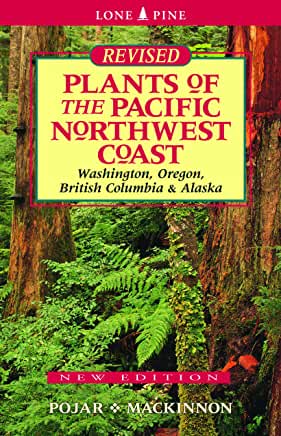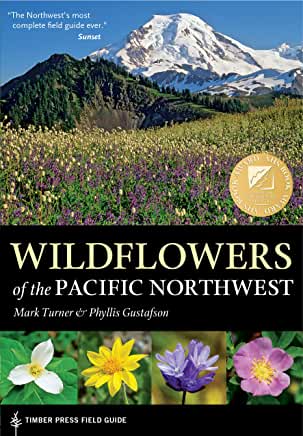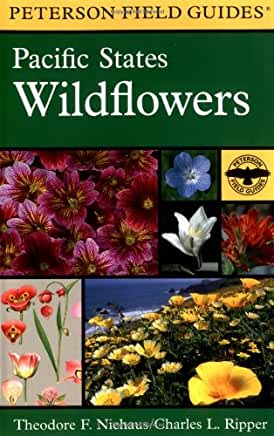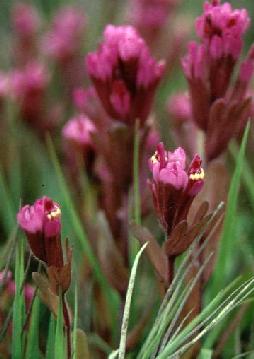Plant Identification Aids
My Favorite Flower Field Guides
by Carol Ralph April 2020
These are the three books I go to most often to look up wildflowers. They have large enough selections that they include most common species. They have illustrations or photos that (usually) show some or all of the plant, not just a close-up of the flower.
 Plants of the Pacific Northwest Coast by Jim Pojar and Andy MacKinnon. (Lone Pine Publishing, 1994 and later editions) This is the best all-round plant field guide I have ever used. As well as wildflowers it includes trees, shrubs, ferns, grasses, aquatics, mosses, and liverworts. It's all here....as long as you stay on the coast. It actually does not intend to cover northern California, so it does not include Redwoods, but our flora otherwise is much more similar to coastal Oregon, Washington, and British Colombia than to California south of here. The many contributing authors clearly really knew their subject plants and were not just describing herbarium specimens or repeating information found in other books. Species descriptions are enriched with notes of Native American uses, history, and fun facts.
Plants of the Pacific Northwest Coast by Jim Pojar and Andy MacKinnon. (Lone Pine Publishing, 1994 and later editions) This is the best all-round plant field guide I have ever used. As well as wildflowers it includes trees, shrubs, ferns, grasses, aquatics, mosses, and liverworts. It's all here....as long as you stay on the coast. It actually does not intend to cover northern California, so it does not include Redwoods, but our flora otherwise is much more similar to coastal Oregon, Washington, and British Colombia than to California south of here. The many contributing authors clearly really knew their subject plants and were not just describing herbarium specimens or repeating information found in other books. Species descriptions are enriched with notes of Native American uses, history, and fun facts.
 Wildflowers of the Pacific Northwest by Mark Turner and Phyllis Gustafson. (Timber Press, 2006 and later edition) Northwestern California is purposely included in the territory of this book. The publisher insisted, saying that Californians buy books. So we are the beneficiaries of Mark Turner's incredible energy in collecting photos of many hundreds of wildflowers. The species chosen for inclusion in the book seems to match what we actually encounter pretty well. And this is the only field guide that does not shy away from the umbellifers (carrot family). Sixteen species of lomatium! Mark clearly likes buckwheats as well--nineteen species of them. You don't have to worry about all of them, because the range maps easily show what is in the county you are in.
Wildflowers of the Pacific Northwest by Mark Turner and Phyllis Gustafson. (Timber Press, 2006 and later edition) Northwestern California is purposely included in the territory of this book. The publisher insisted, saying that Californians buy books. So we are the beneficiaries of Mark Turner's incredible energy in collecting photos of many hundreds of wildflowers. The species chosen for inclusion in the book seems to match what we actually encounter pretty well. And this is the only field guide that does not shy away from the umbellifers (carrot family). Sixteen species of lomatium! Mark clearly likes buckwheats as well--nineteen species of them. You don't have to worry about all of them, because the range maps easily show what is in the county you are in.
 A Field Guide to Pacific States Wildflowers by Theodore F. Niehaus and Charles L. Ripper. (Houghton Mifflin 1976 and earlier and later editions) I am not the only long-time botanizer who sheepishly pulls out this "old-fashioned" book with line drawings, still being amazed at how it features the species we need and shows the characters we need. Covering the entire three Pacific States, it includes many inland, southern, and desert species that are irrelevant to Humboldt County. The newer editions have added some photo pages and presumably have updated the taxonomy.
A Field Guide to Pacific States Wildflowers by Theodore F. Niehaus and Charles L. Ripper. (Houghton Mifflin 1976 and earlier and later editions) I am not the only long-time botanizer who sheepishly pulls out this "old-fashioned" book with line drawings, still being amazed at how it features the species we need and shows the characters we need. Covering the entire three Pacific States, it includes many inland, southern, and desert species that are irrelevant to Humboldt County. The newer editions have added some photo pages and presumably have updated the taxonomy.
Apps for smart phones to help you identify plants have blossomed and multiplied. From my base of great ignorance I can offer only three bits of information. My son gets good results with "Seek," an app that you open and then take a photo of the plant. It tells you what it is or might be. It may be working with iNaturalist, which is a site on which you can open an account and post photos you hope other people will identify. In 2016 (which might be ancient history in the realm of apps) Pam Kessler wrote an article for our newsletter Darlingtonia (summer issue) about an apps and twwo websites that help identify plants: North California Wildflowers by Steven Sullivan, PlantID.net, and Calflora.org. Her article is available in the newsletters archived on our chapter website.
Northtown Books in Arcata will order books for pick-up, with very short delivery times. Check their website.
Follow a link below for more information.
| Willows |
| Ferns |


 Activities
Activities